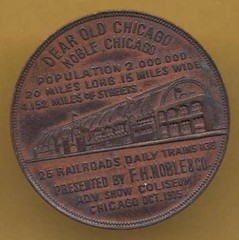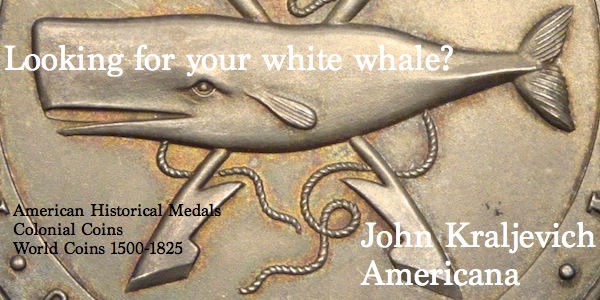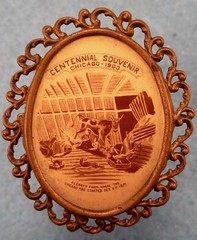
PREV ARTICLE
NEXT ARTICLE
FULL ISSUE
PREV FULL ISSUE
MORE ON MRS. O'LEARY'S COW AND NUMISMATICS


In response to Michael Sanders' question, Rich Hartzog writes:
I recently picked up a celluloid fronted ornate rimmed button featuring the O'Leary cow. This 1903 Centennial Souvenir is a bit over 2" tall, with a pin-back. While I've not been looking for it, it is the first one I've seen. Cute piece, showing the cow kicking the lantern. There are several 1903 Centennial badges, but only these two in O'Leary cow referenced items that I can recall.

Dave Schenkman writes: Regarding the Mrs. O'Leary's cow piece, I devoted a column to it several years ago in "The Numismatist". Here's the text.
Thanks! Here's Dave's article, which has more information on Michael Sanders' medal and one more numismatic item relating to the famous fire. Will any of these be on display at the ANA convention next month?.
-Editor
If you're from Chicago, very likely you already know all about Mrs. O'Leary and her cow. The year was 1871, and the story centers around a forty-something year old lady by the name of Catherine (Kate) O'Leary who lived on the West Side of Chicago. Kate kept an assortment of animals and a wagon in a crowded barn on her property, and made a living by milking her five cows twice a day. As you know, winters in Chicago can be very cold. The O'Learys had prepared well. They had plenty of coal for heating their house, and there was a good supply of hay on hand to feed the animals. The question that remains unanswered to this day is, did Mrs. O'Leary's cow start the Great Chicago Fire of 8 October 1871? According to legend the now-infamous bovine kicked over a kerosene lantern, setting off a blaze which ignited the barn and then the entire block. From there it spread to the South Side of town, resulting in this country's worst disaster to date. Thousands of downtown buildings were destroyed and losses totaled in the hundreds of millions of dollars. But there are other versions of the story. Mrs. O'Leary maintained that she went to bed early that evening, and an official inquiry was not able to establish any guilt on her part. It was also theorized that a meteor fell to earth that night and started the fire. And then there's a press release, written about a man by the name of Louis M. Cohn in 1944 following his death, which said in part that he and Mrs. O'Leary's son, in the company of several other boys, were shooting dice in the hayloft . . . by the light of a lantern, when one of the boys accidentally overturned the lantern, thus setting the barn afire. Cohn even admitted to scooping up the money as he ran from the barn. No matter what her involvement actually was, Mrs. O'Leary has become part of Chicago's history and folklore. In 1938 the legend was revived in a movie titled In Old Chicago. Kate O'Leary became the widow Molly O'Leary, and although the story was changed considerably, the fire was attributed to the now-famous cow, Daisy. In 1905 the well-known Chicago die sinking firm, F. H. Noble and Company, issued a numismatic reminder of the fire. Struck in nickel plated brass on a 32mm planchet, the nine-line inscription on one side of the piece reads DEAR OLD CHICAGO / NOBLE CHICAGO / POPULATION 2.000.000. / 20 MILES LONG 15 MILES WIDE / 4.152 MILES OF STREETS. / 25 RAILROADS DAILY TRAINS 1138 / PRESENTED BY F. H. NOBLE & CO. / ADV. SHOW COLISEUM / CHICAGO. OCT. 1905. A building, which I assume to be the coliseum, is depicted in the center. Depicted on the other side of the piece is a scene of early Chicago, and the following inscription: CHICAGO 1833 / POPULATION 200 / INCORPORATED CITY 1837 / OLEARYS COW / BECAME DISCOURAGED / OCT. 8 1871. THE FIRE WAS / EXTINGUISHED BY RAIN / OCT. 10 SAME YEAR. The medalet was obviously issued for the advertising show mentioned in its inscription. No doubt F. H. Noble & Co. exhibited there, and gave the pieces away as souvenirs or as samples of their work. It is interesting to note the brief, somewhat cryptic, mention of O'Leary's cow. Apparently even in 1905, thirty-four years after the fire, the issuer assumed that the subject matter was so familiar to most people that no additional wording was needed. While writing this article another item relating to the Chicago fire came to mind. This 24mm nickel alloy token is well known to collectors, and it's listing in Dr. Wright's American Business Tokens (number 1544) establishes it as being from the nineteenth century. One side reads NICKEL / FROM THE / RUINS / OF THE / N.W. SHOW CASE MF'G C. / OCT. 9TH 1871. The reverse depicts a showcase, with the inscription RE ESTABLISHED / AT / 59 & 61 S. CANAL ST. / CHICAGO. I imagine it was struck shortly after the fire, when the N.W. Show Case Manufacturing Company relocated and resumed business. The United States Mint even got into the act, striking a 51mm medal which was, as it states in its inscription, MADE FROM THE CHICAGO COURT HOUSE BELL. According to R. W. Julian's Medals Of The United States Mint, where it is listed as CM-13, five hundred of these medals were struck to the order of H. S. Everhard and Company in 1872. The dies were cut by William Barber. To read the earlier E-Sylum article, see: QUERY: DEAR OLD CHICAGO MEDAL INFORMATION SOUGHT (www.coinbooks.org/esylum_v16n29a15.html)

Wayne Homren, Editor The Numismatic Bibliomania Society is a non-profit organization promoting numismatic literature. See our web site at coinbooks.org. To submit items for publication in The E-Sylum, write to the Editor at this address: whomren@gmail.com To subscribe go to: https://my.binhost.com/lists/listinfo/esylum All Rights Reserved. NBS Home Page Contact the NBS webmaster 
|
